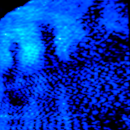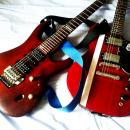Hola!
No son ninguna novedad, pero alucinando estoy que aún no había un hilo específico al respecto. Analógicos "artesanales", manufacturados en USA, analógicos, controles por función, variedad de filtros, control MiDi y CV, etc. Los veo muy completos la verdad.
A groso modo la estructura es la misma en todos, salvando algunas características propias de cada modelo que podéis apreciar en las imágenes. La mayor distinción entre los modelos son las "replicas" de sus filtros.
Empezamos con curiosidades
As SE fans know, we’ve been doing the multiple lter thing for some time, and while our approach has never been one of exact emulation of the original synthesizers—that could only be accomplished if the entire signal path were cloned as well—the focus and purpose was, and remains, to bring the main essence—the “spirit” of the classic originals into our own unique, performance-based platforms, and in the case of the Boomstar accomplish that with as many hardware features, i.e., crossmod, ringmod, overdrive, feedback, that would t! Judging from the many attering remarks (from owners, well-wishers, followers), and downright e usive praise, satisfaction has been achieved—and thanks to all!
Critical Circuit Details: For oscillators we’ve essentially been using the same Moog-based design since our reissue of the MiniMoog® stabilized oscillator board. In the Boomstar synths we replaced the Fairchild cans with 3046s, which are stabilized with temperature compensating resistors placed on top—something very similar to what is in an S.E.M: it gives us just the right amount of warmth and tuning stability. The Moog® lter employed in all our own synths is a clone, except that in the Boomstar 5089, a 3046 replaces the original hand-matched transistors in the top and bottom of the ladder. The resonance produced is lovely; it sits perfectly along with the signal, singing out, but never dominates. The 4075, 3003, and S.E.M. are faithful to the original circuit designs, with some license taken by Tim Caswell in case of the SE80 lter, due to 1970s custom lter ICs employed in Yamaha’s design. The VCA in the BoomStar is the Minioog® VCA, which we used in the SE-1(X) as well, while the Omega and ATC series synths use a VCA incorporating an LM13700, in case you were wondering. These are “through-hole” (to be contrasted with “surface-mount”) and decidedly discrete analog synthesizers: the Holy Grail of PCB assembly procedures, built to last and remain completely serviceable—bound to be necessary if they stick around making people happy as long as we expect them to!
Características comunes en los modelos
Construction
Sturdy steel chassis, 31 pots, 2 rotary switches, 18 toggle switches—15 three way for expanded functionality—AC power triple output desktop adaptor (15, -15 Volt Auto-Switching Supply). Tried and true through-hole technology—not surface mount—for integrity of sound, quality, durability, and serviceability.
Dimentions
Height: 2.05" (52.07 mm) at front, 3.625" (92.075 mm) at back, Width: 8.7 " (220.98 mm), Depth: 7.05" (179.07 mm).
Sound Generation
All discrete circuity, with the exception of the software LFO. Hand matched transistors in filter and amplifier.
Oscillator1
6 position rotary range switch; Two center off toggle switches select combinations of sine, triangle, saw and square waveforms; Pulse width for square waveform; Sub oscillator with center off toggle switch for half and full level positions; Sync oscillator 2 to oscillator 1 switch.
Oscillator2
6 position rotary range switch; Three position toggle switch to select triangle, saw or square waveform; Fine tune pot; Mod depth pot with center off toggle switch to select modulation by envelope 1 or 2; Keyboard tracking on-off switch.
Filter/Envelope1
Frequency and resonance pots; Center off toggle switch to select half and full keyboard tracking; Envelope mod depth pot; Additional mod depth pot with center off toggle to select modulation by oscillator 2 or the LFO. Envelope 1: Attack, decay, sustain, and release pots; Center off toggle switch to select envelope invert or envelope loop.
Filter Types
5089—classic Moog® 24dB ladder, 4075—classic ARP® 2600; SEM—classic Oberheim® 12dB SEM; 3003—classic Roland® TB-303; 700—classic MiniKorg®; SE80—classic Yamaha® CS-80.
Envelope 2
Attack, decay, sustain, and release pots; Center off toggle switch to select envelope invert or LFO gate trigger; Single or multiple triggering switch; Center off toggle switch to select drone and envelope 1 as master. With master selected, envelope 2 is the modulator for both the amplifier and filter frequency. Envelope 1 remains active for oscillator 2 frequency and oscillator 1 pulse width modulation.
XMod
Oscillator 2 mod depth pot with center off toggle switch to select modulation of oscillator 1 pulse width or oscillator 1 frequency.
LFO
Rate pot; MIDI sync on-off switch; Waveform pot: sine, triangle, saw up, saw down, square, offset square 1 and 2, random and slew random waveforms; Mod depth pot with center off toggle switch to select oscillator 1 frequency or oscillator 1 pulse width; Mod depth pot with center off toggle switch to select oscillator 2 frequency or oscillator 2 pulse width.
Amplifier
Center off toggle switch to select two levels of overdrive; Volume pot.
Tuning
Master tune pot.
Bender
Bend range pot.
Glide
Hardware exponential glide time pot.
Dynamics
(routes MIDI keyboard) Dynamics to filter frequency pot.
Envelope 1 to Pulse Width 1 (ENV1> PW1)
(routes) Envelope 1 to Oscillator 1 pulse width pot.
Mixer - OSC
Oscillator 1 level pot; Oscillator 2 level pot.
Mixer - Ring Mod
Hardware Ring Modulator level pot.
Mixer - Noise
Noise level pot.
Mixer - Feedback
(routes the synth's output back through the filter) Feedback level pot.
Front Panel Jacks
CV in, Gate in, Filter frequency modulation in, Amplifier modulation in, Oscillator out, External signal in.
Back Panel Jacks
MIDI In, MIDI Out, 1/4" Audio out, Traveller input (SE80 model only), DC power input.
Back Panel Switches
Learn switch: Selects MIDI channel.
Overflow Switch
For chaining together multiple Boomstars together via MIDI overflow.
Los agujeritos del frontal añaden otros ajustes
- CV input tracking
- Oscillator 1 high tune
- Oscillator 1 octave
- Oscillator 1 initial tune
- Oscillator 1 scale
- Oscillator 2 scale
- Oscillator 2 initial tune
- Oscillator 2 high tune
- Oscillator 2 octave
- Envelope Drive
- VCA Offset
- VCA DC Balance
Estos parámetros son calibraciones para ajustes con conocimiento de causa y se recomienda encarecidamente esta herramienta o similar:
Aspectos MiDi
The MIDI OUT connection functions as a thru as well. The MIDI IN is self-explanatory. The OVERFLOW switch sets the MIDI overflow parameters for chaining multiple Boomstar synths together. To do this, activate the first unit’s OVERFLOW switch, and the last unit in the “chain” OVERFLOW switch disengaged. Note: For proper usage of a single Boomstar, make certain the OVERFLOW switch is deactivated, or the note buffer will be reduced to 0, and note dropouts will occur with legato playing; however, OVERFLOW function can be useful when the Boomstar is used in conjunction with a hardware step sequencer, which may or may not send the appropriate note-off commands. The MIDI LEARN switch sets the MIDI channel: play on the channel desired, press the LEARN switch momentarily, release, and the Boomstar “learns” the channel. Note: Boomstar OS software prior to Version 2 does not remember the channel after powering down. Upon powering up those Boomstars, the channel
Demos y características específicas
SE Boomstar SEM (réplica filtro OTA Oberheim SEM LPF 12dB/oct+Q y ¿HPF?/notch/BPF de 12dB/oct) (full function with LP to HP mix control)
SE Boomstar SE80 (réplica filtro yamaha CS cascada LPF 24dB/oct+Q y cascada HPF ¿6-12?dB/oct+Q)
SE Boomstar 4075 (réplica filtro cascada LPF 24dB/oct auto-oscilante ARP 2600)
SE Boomstar 700 (réplica filtro cascada MiniKorg 700-s LPF 24dB/oct+Q y HPF ¿6-12?dB/oct+Q) (¿descontinuado?)
SE Boomstar 3003 (réplica filtro cascada LPF 18dB/oct auto-oscilante diodo Roland TB-303)
SE Boomstar 5089 (réplica filtro cascada LPF 24dB/oct+Q auto-oscilante ladder Moog Minimoog)
Aparentes envolventes ràpidas para persuciones
Esquema patch inicial (sawtooth bass)
Manual
Posibilidad de enracar los módulos
Con lo básico -y no tanto- de cualquier simtetizador que se precie; sobre todo analógicos 100%.
Quizá alguien prefiera coger su réplica favorita o escoger el más completo según su criterio.
Como buenos analógicos que son, no guardan patches/presets -similar Minibrute/Microbrute-, por lo cual hay a disposición del usuario un par de plantillas para rotular los ajustes: SE80/700 y 5089/4075/3003/SEM
Como conclusión final, hay analógicos más baratos, pero tan completos en características y a control por función me parece que no. Son muy a tomar en cuenta, sobre todo si se ve alguno de 2ª mano que lo dudo.
Reviews válidas para todos los modelos
Greatsynthesizers.com
Keyboardmag.com
Musicradar.com
Musictech.net
Musictech.net
Soundonsound.com
Toda la información e ilustraciones han sido sacadas de la web de Studio Electronics Analogia Inc., salvo ciertos videos de Youtube donde puede reconocerse su autoría.
Se ha tratado de esclarecer lo máximo posible la diferencia entre las versiones, ya que algunos aspectos no están muy claros.
Un saludo.
No son ninguna novedad, pero alucinando estoy que aún no había un hilo específico al respecto. Analógicos "artesanales", manufacturados en USA, analógicos, controles por función, variedad de filtros, control MiDi y CV, etc. Los veo muy completos la verdad.
A groso modo la estructura es la misma en todos, salvando algunas características propias de cada modelo que podéis apreciar en las imágenes. La mayor distinción entre los modelos son las "replicas" de sus filtros.
Empezamos con curiosidades
As SE fans know, we’ve been doing the multiple lter thing for some time, and while our approach has never been one of exact emulation of the original synthesizers—that could only be accomplished if the entire signal path were cloned as well—the focus and purpose was, and remains, to bring the main essence—the “spirit” of the classic originals into our own unique, performance-based platforms, and in the case of the Boomstar accomplish that with as many hardware features, i.e., crossmod, ringmod, overdrive, feedback, that would t! Judging from the many attering remarks (from owners, well-wishers, followers), and downright e usive praise, satisfaction has been achieved—and thanks to all!
Critical Circuit Details: For oscillators we’ve essentially been using the same Moog-based design since our reissue of the MiniMoog® stabilized oscillator board. In the Boomstar synths we replaced the Fairchild cans with 3046s, which are stabilized with temperature compensating resistors placed on top—something very similar to what is in an S.E.M: it gives us just the right amount of warmth and tuning stability. The Moog® lter employed in all our own synths is a clone, except that in the Boomstar 5089, a 3046 replaces the original hand-matched transistors in the top and bottom of the ladder. The resonance produced is lovely; it sits perfectly along with the signal, singing out, but never dominates. The 4075, 3003, and S.E.M. are faithful to the original circuit designs, with some license taken by Tim Caswell in case of the SE80 lter, due to 1970s custom lter ICs employed in Yamaha’s design. The VCA in the BoomStar is the Minioog® VCA, which we used in the SE-1(X) as well, while the Omega and ATC series synths use a VCA incorporating an LM13700, in case you were wondering. These are “through-hole” (to be contrasted with “surface-mount”) and decidedly discrete analog synthesizers: the Holy Grail of PCB assembly procedures, built to last and remain completely serviceable—bound to be necessary if they stick around making people happy as long as we expect them to!
Características comunes en los modelos
Construction
Sturdy steel chassis, 31 pots, 2 rotary switches, 18 toggle switches—15 three way for expanded functionality—AC power triple output desktop adaptor (15, -15 Volt Auto-Switching Supply). Tried and true through-hole technology—not surface mount—for integrity of sound, quality, durability, and serviceability.
Dimentions
Height: 2.05" (52.07 mm) at front, 3.625" (92.075 mm) at back, Width: 8.7 " (220.98 mm), Depth: 7.05" (179.07 mm).
Sound Generation
All discrete circuity, with the exception of the software LFO. Hand matched transistors in filter and amplifier.
Oscillator1
6 position rotary range switch; Two center off toggle switches select combinations of sine, triangle, saw and square waveforms; Pulse width for square waveform; Sub oscillator with center off toggle switch for half and full level positions; Sync oscillator 2 to oscillator 1 switch.
Oscillator2
6 position rotary range switch; Three position toggle switch to select triangle, saw or square waveform; Fine tune pot; Mod depth pot with center off toggle switch to select modulation by envelope 1 or 2; Keyboard tracking on-off switch.
Filter/Envelope1
Frequency and resonance pots; Center off toggle switch to select half and full keyboard tracking; Envelope mod depth pot; Additional mod depth pot with center off toggle to select modulation by oscillator 2 or the LFO. Envelope 1: Attack, decay, sustain, and release pots; Center off toggle switch to select envelope invert or envelope loop.
Filter Types
5089—classic Moog® 24dB ladder, 4075—classic ARP® 2600; SEM—classic Oberheim® 12dB SEM; 3003—classic Roland® TB-303; 700—classic MiniKorg®; SE80—classic Yamaha® CS-80.
Envelope 2
Attack, decay, sustain, and release pots; Center off toggle switch to select envelope invert or LFO gate trigger; Single or multiple triggering switch; Center off toggle switch to select drone and envelope 1 as master. With master selected, envelope 2 is the modulator for both the amplifier and filter frequency. Envelope 1 remains active for oscillator 2 frequency and oscillator 1 pulse width modulation.
XMod
Oscillator 2 mod depth pot with center off toggle switch to select modulation of oscillator 1 pulse width or oscillator 1 frequency.
LFO
Rate pot; MIDI sync on-off switch; Waveform pot: sine, triangle, saw up, saw down, square, offset square 1 and 2, random and slew random waveforms; Mod depth pot with center off toggle switch to select oscillator 1 frequency or oscillator 1 pulse width; Mod depth pot with center off toggle switch to select oscillator 2 frequency or oscillator 2 pulse width.
Amplifier
Center off toggle switch to select two levels of overdrive; Volume pot.
Tuning
Master tune pot.
Bender
Bend range pot.
Glide
Hardware exponential glide time pot.
Dynamics
(routes MIDI keyboard) Dynamics to filter frequency pot.
Envelope 1 to Pulse Width 1 (ENV1> PW1)
(routes) Envelope 1 to Oscillator 1 pulse width pot.
Mixer - OSC
Oscillator 1 level pot; Oscillator 2 level pot.
Mixer - Ring Mod
Hardware Ring Modulator level pot.
Mixer - Noise
Noise level pot.
Mixer - Feedback
(routes the synth's output back through the filter) Feedback level pot.
Front Panel Jacks
CV in, Gate in, Filter frequency modulation in, Amplifier modulation in, Oscillator out, External signal in.
Back Panel Jacks
MIDI In, MIDI Out, 1/4" Audio out, Traveller input (SE80 model only), DC power input.
Back Panel Switches
Learn switch: Selects MIDI channel.
Overflow Switch
For chaining together multiple Boomstars together via MIDI overflow.
Los agujeritos del frontal añaden otros ajustes
- CV input tracking
- Oscillator 1 high tune
- Oscillator 1 octave
- Oscillator 1 initial tune
- Oscillator 1 scale
- Oscillator 2 scale
- Oscillator 2 initial tune
- Oscillator 2 high tune
- Oscillator 2 octave
- Envelope Drive
- VCA Offset
- VCA DC Balance
Estos parámetros son calibraciones para ajustes con conocimiento de causa y se recomienda encarecidamente esta herramienta o similar:
Aspectos MiDi
The MIDI OUT connection functions as a thru as well. The MIDI IN is self-explanatory. The OVERFLOW switch sets the MIDI overflow parameters for chaining multiple Boomstar synths together. To do this, activate the first unit’s OVERFLOW switch, and the last unit in the “chain” OVERFLOW switch disengaged. Note: For proper usage of a single Boomstar, make certain the OVERFLOW switch is deactivated, or the note buffer will be reduced to 0, and note dropouts will occur with legato playing; however, OVERFLOW function can be useful when the Boomstar is used in conjunction with a hardware step sequencer, which may or may not send the appropriate note-off commands. The MIDI LEARN switch sets the MIDI channel: play on the channel desired, press the LEARN switch momentarily, release, and the Boomstar “learns” the channel. Note: Boomstar OS software prior to Version 2 does not remember the channel after powering down. Upon powering up those Boomstars, the channel
Demos y características específicas
SE Boomstar SEM (réplica filtro OTA Oberheim SEM LPF 12dB/oct+Q y ¿HPF?/notch/BPF de 12dB/oct) (full function with LP to HP mix control)
SE Boomstar SE80 (réplica filtro yamaha CS cascada LPF 24dB/oct+Q y cascada HPF ¿6-12?dB/oct+Q)
SE Boomstar 4075 (réplica filtro cascada LPF 24dB/oct auto-oscilante ARP 2600)
SE Boomstar 700 (réplica filtro cascada MiniKorg 700-s LPF 24dB/oct+Q y HPF ¿6-12?dB/oct+Q) (¿descontinuado?)
SE Boomstar 3003 (réplica filtro cascada LPF 18dB/oct auto-oscilante diodo Roland TB-303)
SE Boomstar 5089 (réplica filtro cascada LPF 24dB/oct+Q auto-oscilante ladder Moog Minimoog)
Aparentes envolventes ràpidas para persuciones
Esquema patch inicial (sawtooth bass)
Manual
Posibilidad de enracar los módulos
Con lo básico -y no tanto- de cualquier simtetizador que se precie; sobre todo analógicos 100%.
Quizá alguien prefiera coger su réplica favorita o escoger el más completo según su criterio.
Como buenos analógicos que son, no guardan patches/presets -similar Minibrute/Microbrute-, por lo cual hay a disposición del usuario un par de plantillas para rotular los ajustes: SE80/700 y 5089/4075/3003/SEM
Como conclusión final, hay analógicos más baratos, pero tan completos en características y a control por función me parece que no. Son muy a tomar en cuenta, sobre todo si se ve alguno de 2ª mano que lo dudo.
Reviews válidas para todos los modelos
Greatsynthesizers.com
Keyboardmag.com
Musicradar.com
Musictech.net
Musictech.net
Soundonsound.com
Toda la información e ilustraciones han sido sacadas de la web de Studio Electronics Analogia Inc., salvo ciertos videos de Youtube donde puede reconocerse su autoría.
Se ha tratado de esclarecer lo máximo posible la diferencia entre las versiones, ya que algunos aspectos no están muy claros.
Un saludo.


















